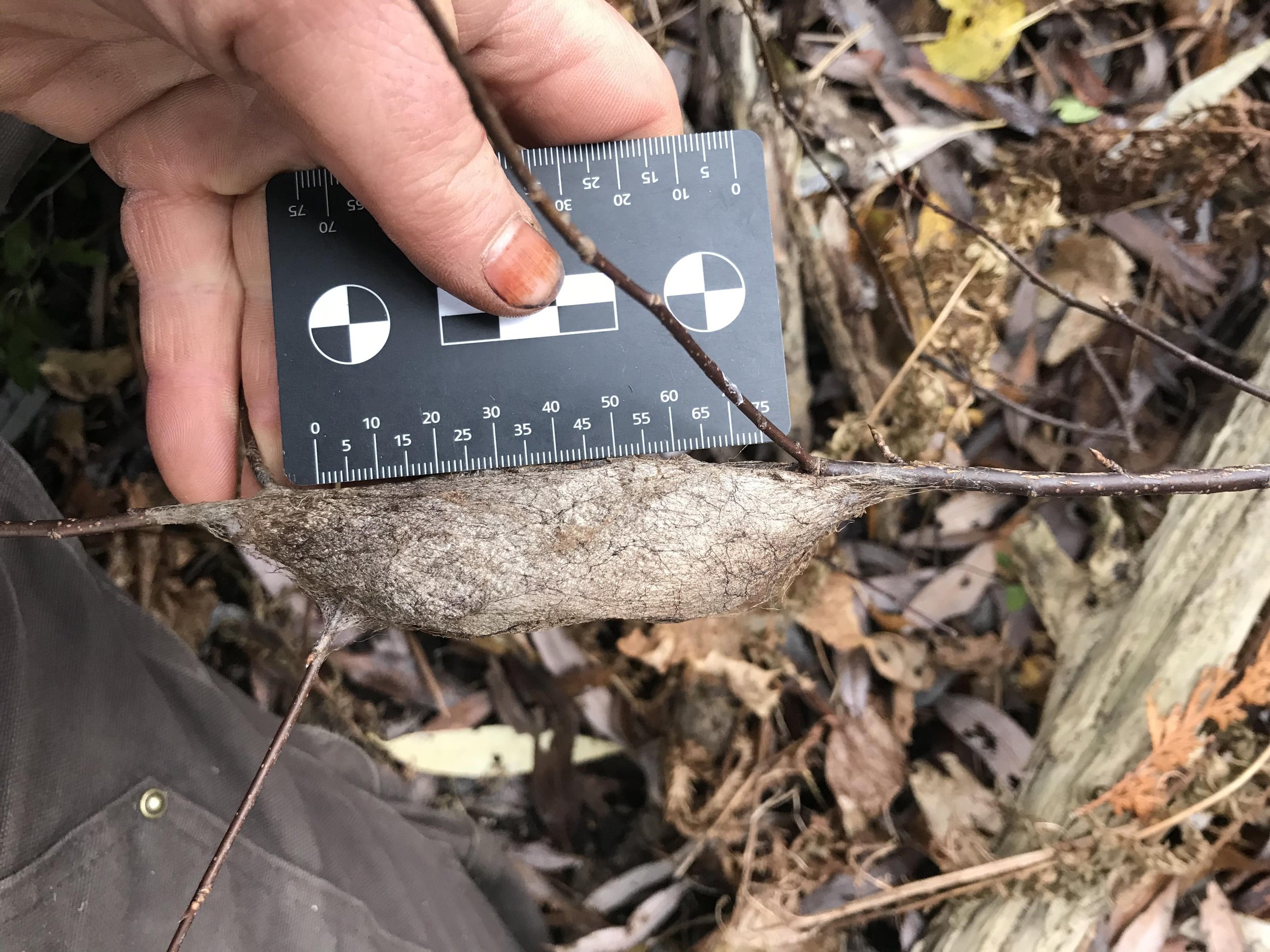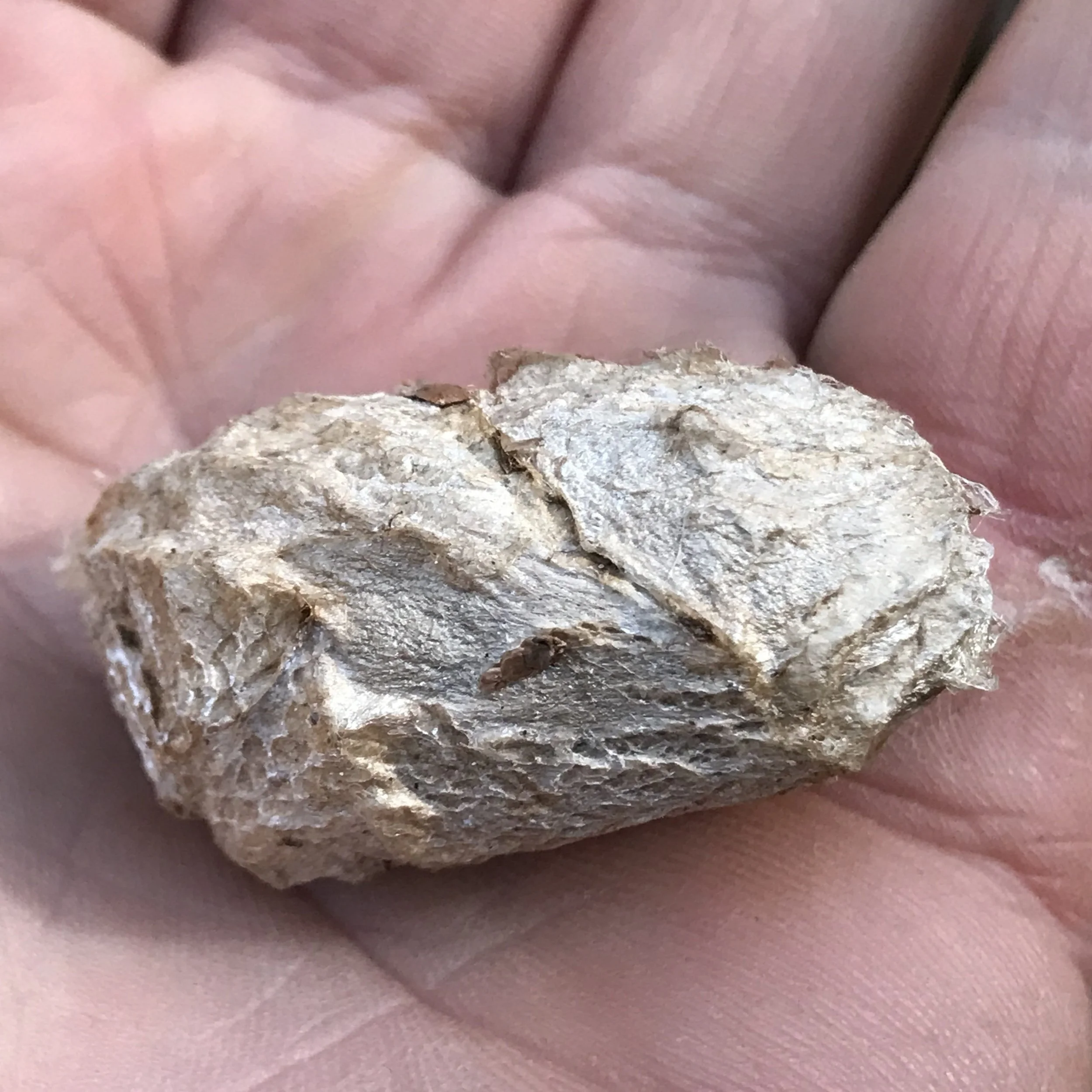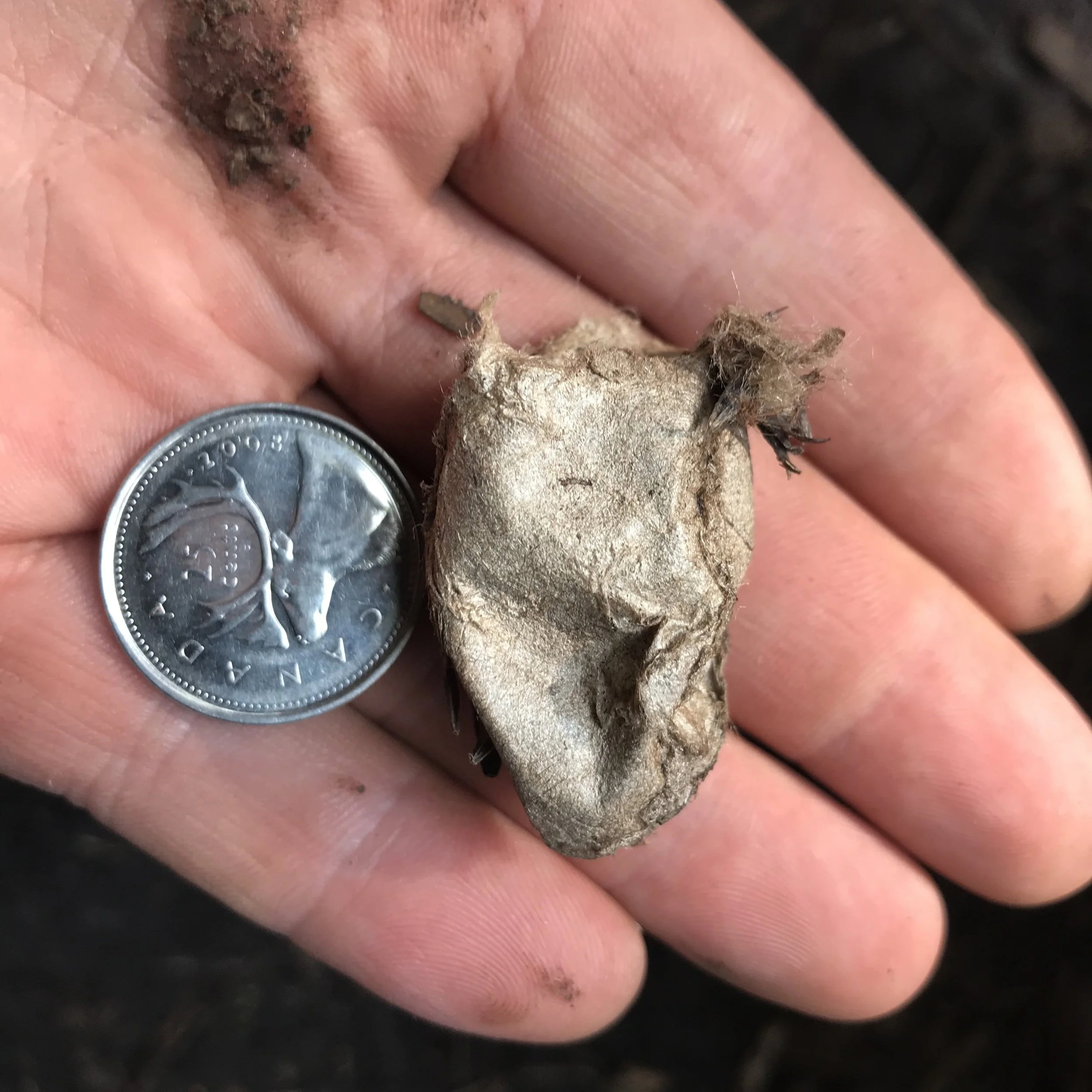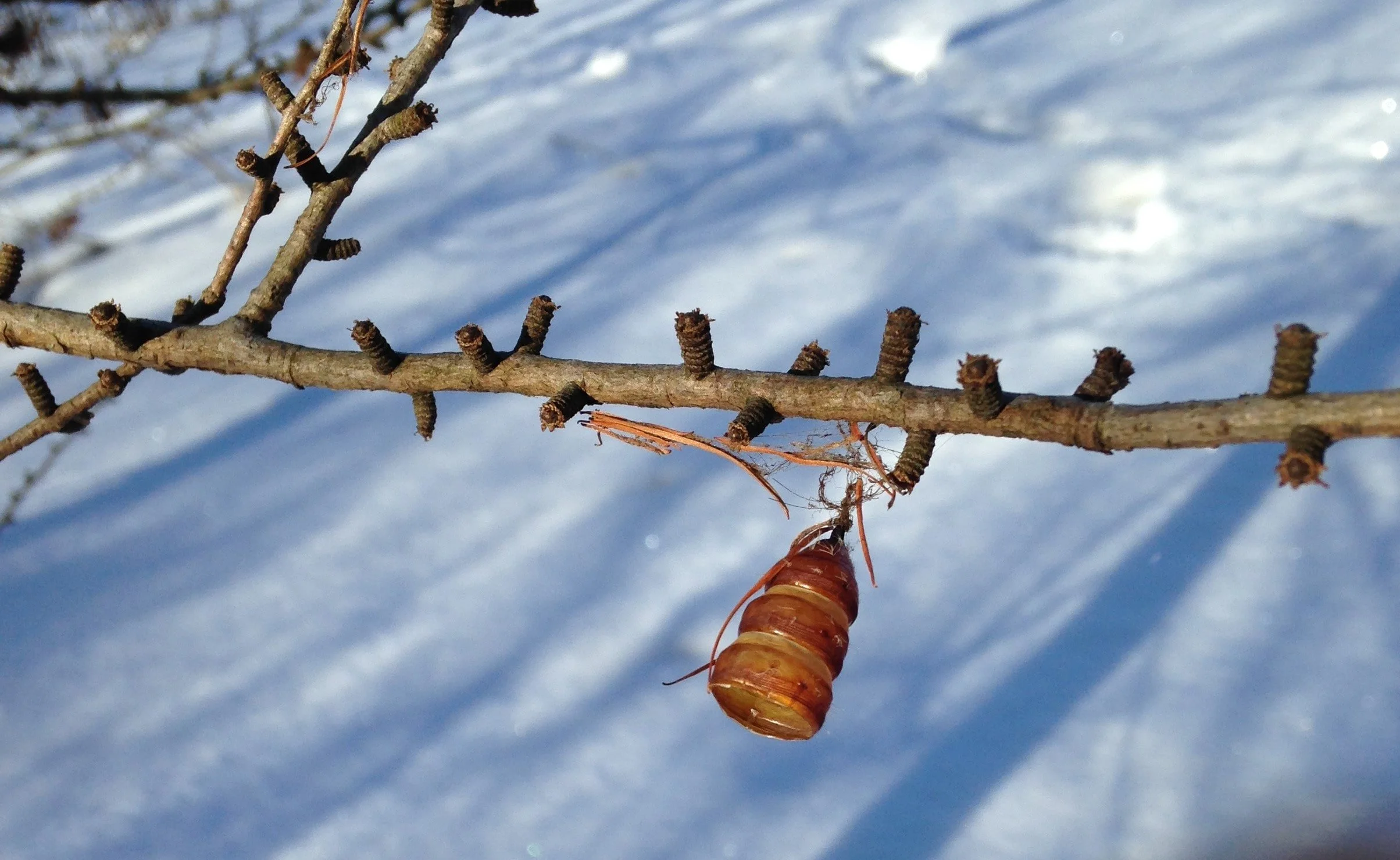Three Common Silk Moth Cocoons
Throughout the past few years I have come across a few different large cocoons belonging to Silk Moths, who are large moths in the family Saturniidae, in the order Lepidoptera. As I encounter the cocoons I tend to look them up and try to learn something about them but eventually the individual identifications of each unique species is lost, except maybe the Cecropia. I wanted to write a short blog post, starting with the main three cocoons I encounter, helping to remember who makes which cocoons so I can better remember in the field. But first, I have some questions.
Partial pupal case from a Spongy Moth (Lymantria dispar) - not a Silk Moth - on Tamarack (Larix laricina).
What is the difference between a chrysalis vs pupa vs cocoon?
A simple yet refined definition of a cocoon is the silken fibrous case that a larva creates around themselves for a protective covering while pupating. Silk Moths produce silk (made of keratin based “fibroins”) from their salivary glands. They spin it around themselves in shapes particular to the species, and enclose themselves before they begin their penultimate molt to their pupal form. For butterflies the pupal form is called a chrysalis, though I hear pupa and chrysalis used interchangeably.
Some Silk Moths make their cocoons on the ground, some loosely dangle from trees, some are attached along a twig. The variable forms are indicative of species, which allows for easier identification, even when we cannot see the animal themselves. I am curious if the differences in form meet a functional need in the pupation process or if the diversity in shape just enables better camouflage? Camouflage is necessary as many cocoons are found by predators and parasites of the transforming pupae, from hungry birds to wasps looking for somewhere safe to lay their eggs.
The life cycle of a Silk Moth
Silk Moths spend the Winter in their cocoon where their caterpillar has practically dissolved in preparation for metamorphosis into their beautiful future moth selves. In Spring the newly formed moths emerge, ready to fly and mate. Once they have mated, the gravid females lay their eggs on the leaves of their favorite host plants. These eggs generally hatch in 10 - 12 days. Over the next four months the caterpillars eat and grow, some up to about 10 cm (~4 in) long! In the Autumn these caterpillars will build their cocoons and overwinter/pupate within them until Spring when the cycle begins again!
Species of Silk Moth in Southern Ontario



Cecropia Moth (Hyalophora cecropia)
Larval host plants : Ash, Cherry, Apple, Lilac, Poplar, Willow, Maple.
Description of cocoon : ~ 10 cm (4”) long, attached along length of a twig, usually found around 40 cm (15 ¾ in) and lower to the ground. Puffy baggy looking. The silk is brown.
Notes : Largest moth in Ontario.
Cocoon similar to Columbia Silk Moth (Hyalophora columbia)* cocoon which tends to be more stringy and threadbare than the Cecropia cocoon from images I have see.
*Columbia: Spindle shaped, attached lengthwise to twigs on shrub or tree branches. The silk is brown with prominent silvery hairs.
Promethea Moth cocoon at the University of Guelph Arboretum
Promethea Moth (Callosamia promethea)
Larval host plants : Deciduous trees and shrubs such as Apple, Ash, Basswood, Lilac, Magnolia, Maple, Cherry, Birch, Tulip tree, Sassafras.
Description of cocoon : Roughly 5.5 cm (2⅛ in). Elongated, and narrow. Opening at top to allow for easier emergence in early Summer.
Notes : Before pupating the Promethea caterpillar will reinforce the stem of a leaf (petiole) with silk to ensure that the leaf remains attached to the host plant throughout the Winter. They then create their cocoon inside of the curled leaf. The cocoon hangs from the host plant throughout the winter. Silk is light brown or grey in colour.
“Young Cherry or Sassafras growing between plowed fields and along roads make especially good starting points for larval searches or Winter time cocoon hunts. Look on understory plants and low branches - they are seldom out of reach.” - Caterpillars of Eastern North America by David L. Wagner.
Polyphemus Moth (Antheraea polyphemus)




Larval host plants : Ash, Birch, Dogwood, Elm, Grape, Hickory, Maple, Oak, Pine, Rose, Willow.
Description of cocoon : Oval shaped, ~4.5 cm (1¾ in) usually spun with leaves in outer layer, though often found in the leaf litter. I have read and seen photographs of the cocoon dangling from a low branch similar to Promethea Moth cocoon. The silk is pale cream to white in colour until the caterpillar excretes a substance that toughens up the cocoon and changes the colour to a pale brown.
Notes : Woodlands and forests. Similar to Luna Moth (Actias luna) in size and shape though Polyphemus cocoon is thicker and more evenly oval and less squareish. Unlike other Saturniid moth cocoons, Polyphemus cocoon is entirely closed with no exit hole built in. Pupa will secrete an enzyme to help break down the cocoon when ready to emerge.
Next step is to find more species of Silk Moth cocoons and learn to identify them. What do they look like when they’ve just been created? What do they look like a couple of months after the moths have emerged? Who eats them afterwards/how do they break down/how long does it take for them to break down?
So much to know. The mystery never settles.
To learn more :
ON Nature Magazine Moth and Butterfly Guide by Dan Schneider and Peter Paulter
Tracks and Sign of Insects and Other Invertebrates by Charley Eiseman and Noah Charney. Stackpole Books, 2010.
Caterpillars of Eastern North America by David L. Wagner. Princeton University Press, 2005.


